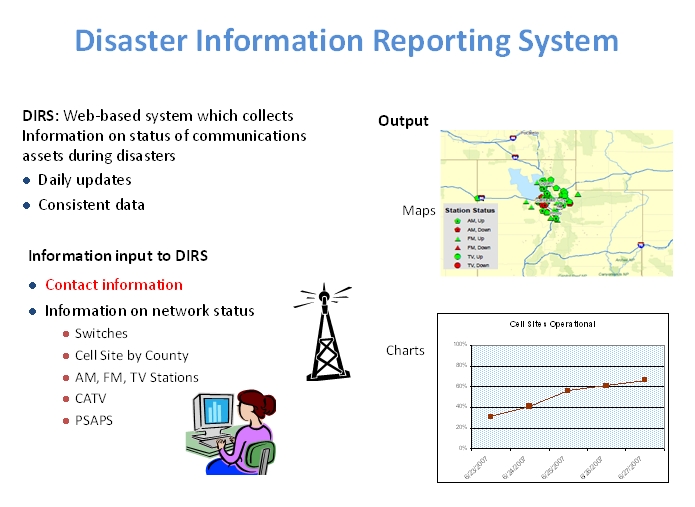Unfortunately disasters happen. Government agencies including the Federal Emergency Management Agency (FEMA), the National Communications System (NCS) and the Office of Science and Technology Policy in the White House need to know the status of communications systems and services during and after a disaster. The FCC's Public Safety and Homeland Security Bureau developed the voluntary Disaster Information Reporting System (DIRS) to collect this information during major disasters.
When a disaster strikes, the FCC asks wireline carriers, wireless carriers, broadcasters and CATV providers to provide information on the condition of their systems in the disaster area. This includes information on switches, E 9-1-1 call centers, broadcast stations, and fiber-optic cable routes. The DIRS system organizes the information into tables, charts and maps that will accurately depict the status of communications in the disaster area. This information can be used to determine which communications service providers might need assistance with restoration efforts. Although the information provided by companies into DIRS is treated as confidential, DIRS has been set-up to provide aggregate information almost instantaneously to those Federal agencies with a need to know.

On Friday, August 6, the FCC issued a Public Notice asking broadcasters to enroll in DIRS. Although the Public Notice is focused on broadcasters, all communications providers are encouraged to enroll. During a disaster, all the companies with communications assets in the disaster area will be asked to provide information into DIRS. Although providing information to DIRS is voluntary, an accurate picture of communications status depends on complete information from all sources.
DIRS has been used to collect information for Hurricanes Gustav and Ike in 2008 and the ice storms in Kentucky in 2009. Hopefully, 2010 will be a quiet year but, if it is not, DIRS will be the essential tool to track communications status and restoration efforts.
Click here for more information on DIRS.